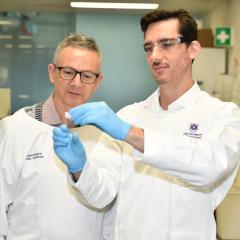27th October 2013
University of Queensland (UQ) scientists have made a fundamental breakthrough into how the brain decodes the visual world.
The retina, a thin neuronal network located at the back of the eye, transmits visual information to the brain. Disturbance of this network by disease, such as macular degeneration, leads to blindness.
Using advanced electrical recording techniques, researchers at the Queensland Brain Institute (QBI) have discovered how the output cells of the retina compute the direction that objects move in the visual world.
By making electrical recordings from retinal cells, Dr Ben Sivyer and Associate Professor Stephen Williams have uncovered the essential part that dendrites – the branched extensions of cells that receive input signals – play in decoding visual images.
“Our work over the last ten years has shown that dendrites provide neurons with powerful processing capabilities, however the function of dendritic processing in the real-time operation of neuronal networks has remained elusive,” says Associate Professor Williams.
To gain greater insight, the group measured electrical activity from multiple sites in retinal ganglion cells when visual stimuli moved through space.
“The retina is an ideal system to investigate the role of active dendritic integration in neuronal circuit function, because this network can be maintained intact in a dish and retains its responsiveness to natural stimuli,” he said.
Whilst it has long been known that the retinal network extracts and signals specific aspects of visual stimuli, the new work is the first to discover how such responses are computed.
“We found that retinal ganglion cells compute the direction of light stimuli through exquisitely controlled local integration compartments in the dendritic tree, a finding which highlights the key function that dendrites play in brain computations,” said Associate Professor Williams.
QBI Director Professor Perry Bartlett says this understanding of how the brain computes information is vital to brain research.
“Discovering how nerve cells process information is fundamental to understanding how we learn, and to developing new strategies to enhance learning in education and in disease processes in the brain,” he said.
Queensland Minister for Science and Innovation Ian Walker congratulated Dr Sivyer and Associate Professor Williams on their internationally significant findings.
“This is another example of Queensland leading the world in health and medical research,” he said.
“Dendrite research also has flow-on implications for brain-function studies in a range of areas.
“While all of these areas are important, I will be particularly interested to see its application to dementia research, which has been a major focus for recent Queensland Government support.”
The paper, Direction selectivity is computed by active dendritic integration in retinal ganglion cells, is published in the prestigious journal Nature Neuroscience.
www.nature.com/neuro/journal/vaop/ncurrent/full/nn.3565.html



